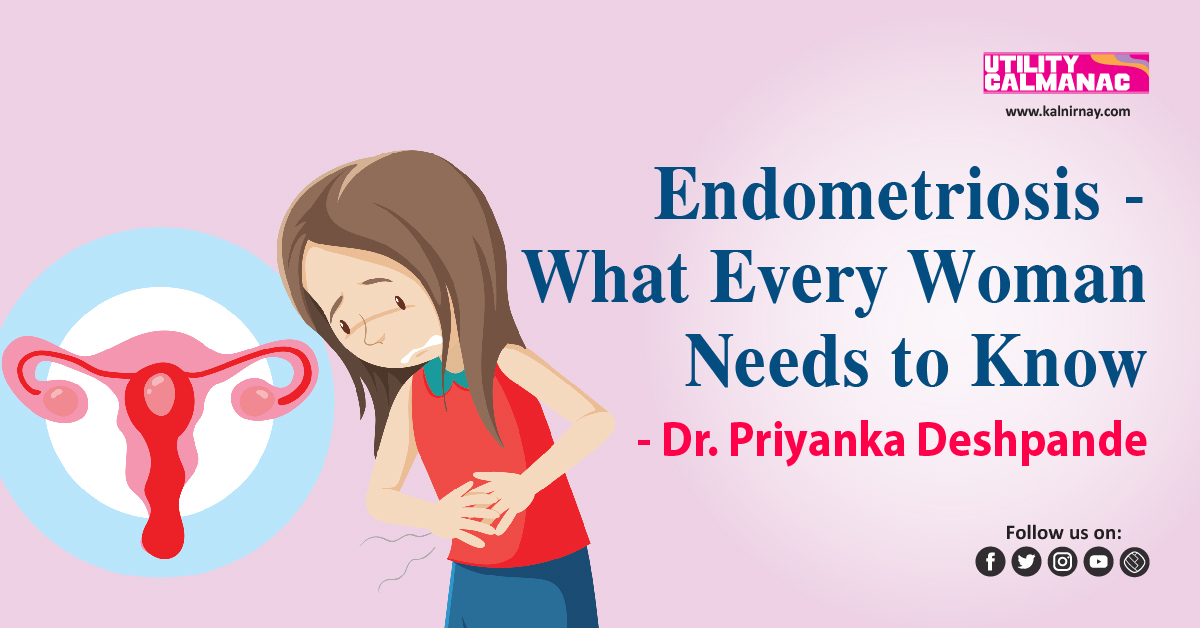Endometriosis – What Every Woman Needs to Know
Endometriosis affects a large population of women. Let’s look at how to detect it early.
Women’s health is a widely-discussed topic, especially when it comes to painful menstruation, pregnancy health, post-partum issues, etc. Health gurus and medical publications have been discussing PCOS, heavy bleeding, infertility, etc., for a while now, and endometriosis is the latest hot topic.
Menstruation is a significant milestone in any woman’s life. It is seen as the point of transition from ‘girlhood’ to ‘womanhood’. Menstruation, popularly known as periods, aunty flo, menses, chums, etc., involves a communication between the brain and the reproductive organs to produce two important hormones – estrogen and progesterone. Estrogen helps the lining of the womb to grow thicker (while preparing for a baby), and progesterone works to stabilise it. In the absence of a pregnancy, these hormones are withdrawn and the lining is shed. This process, which takes place over 30-45 days, is called a menstrual cycle.
In the early 1900s, American physician Dr John A. Sampson observed some period-like bleeding outside the uterus while operating on some women while they were menstruating. This led to the discovery that the endometrial lining of the womb could grow elsewhere in the body. He named this phenomenon endometriosis. The causes of this disorder depend on various factors such as hormonal health, genetics and potentially, environmental contaminants.
Recent studies show that endometriosis affects roughly 19 crore women of reproductive age (19-50); that is about one in ten women. The Endometriosis Society of India estimates that 2.5 crore Indian women suffer from this condition. Between 20-50% of these women may suffer from infertility as a result of this disease.
Symptoms
Typically, women grin and bear their painful periods, which is one of the most common symptoms of this chronic condition. Some other symptoms include severe pain during sexual intercourse, bowel movements or urination; chronic pelvic pain, abdominal bloating, nausea, fatigue, and sometimes depression, anxiety, and infertility. Often, this pain can be debilitating and can affect the quality of life.
Often, discussions around periods are done in hushed tones (although that is positively changing in urban India). Women are expected to accept painful periods as part of their routine life. This lack of open discussion leads to women often relying on painkillers or other coping mechanisms to get through those days of pain. The symptoms may start at any time and can worsen with age. Since the symptoms are vague and vary from patient to patient, there is often a delay in diagnosis and treatment. Some women might have no symptoms, but the condition might present itself during an investigation related to their fertility issues or general reproductive health.
Diagnosis
Earlier, a laparoscopy or biopsy was considered the gold standard for diagnosing this condition. However, according to the National Institute of Clinical Excellence (NICE), the above-stated symptoms and an MRI scan are now considered good enough to confirm the diagnosis.
In some cases, sonography can be helpful, too. Typically, if you are of reproductive age and have chronic pain during periods of intercourse and bowel movements that do not resolve, it is best to make an appointment to check for endometriosis. This cannot be detected through a blood test. Lesions can occur around the pelvic area, in your ovaries, uterus, fallopian tubes, bladder and bowel and require imaging to diagnose.
Treatment
As severe as this disorder may sound, there is no need to panic. Let us understand how this disorder works. It starts with ovulation. This is when your ovaries release an egg at the mid-point of your menstrual cycle. The hormone estrogen, which is released to thicken the uterus lining, also supports the growth of endometriotic cells outside of the uterus.
Progesterone is a natural counter to estrogen. Modern-day treatment for this disorder is mostly non-invasive. Depending on various factors, the doctor might start by prescribing an oral treatment that will focus on pain relief and prevention of the growth of these cells outside the womb. If there is no relief, then the doctors may consider intrauterine devices. However, in severe cases, surgery might be suggested.
As these lesions can recur due to various factors, doctors are now exploring alternative therapies like acupuncture, Yoga and Ayurveda. Doctors and nutritionists also recommend limiting certain foods like soya, flax seed, sesame seeds, dairy, alcohol and red meat, etc. Research shows that these food items tend to aggravate endometriosis symptoms. Doctors also recommend fish oil capsules in combination with vitamin B12 as they reduce the symptoms.
With public personalities like Padma Lakshmi, Lena Dunham, and Whoopi Goldberg coming out to talk about their battle with this disorder, awareness is on the rise. But, we need to normalise everyday conversations around this topic to make a difference. Early diagnosis can help alleviate much pain and suffering for young girls. Although endometriosis is a benign condition, it deeply affects the quality of life. Debilitated by their pain, some women find it impossible to function normally. Anxiety, low self-esteem and depression are also known to afflict women who suffer from this chronic disease. Some even lose their jobs or end up performing poorly at school as a result of this condition. It is important to treat it on a physical and emotional level.
March is observed as Endometriosis Awareness Month with a yellow ribbon as the symbol. Remember that normal periods do not cause excruciating pain but endometriosis does!
To read more English blogs, please visit our blog section.
Dr. Priyanka Deshpande
The author is an OBGYN and is currently a clinical fellow at Cambridge University.

